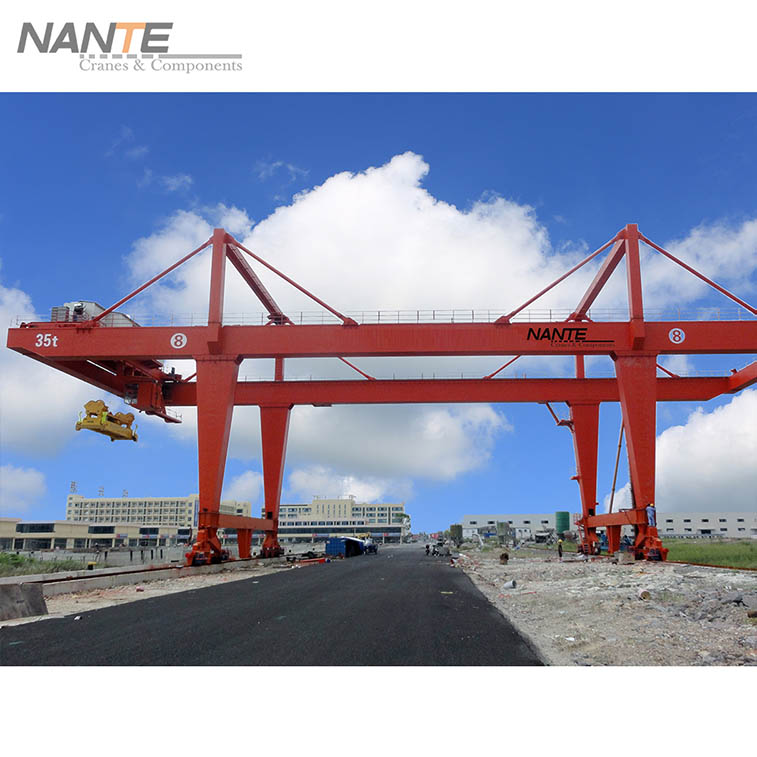How to Properly Install a Gantry Crane A Step-by-Step Guide
Date: 2024-07-23 Share:
A gantry crane is an overhead lifting device that is designed to lift and move heavy loads. It operates on a set of legs that run along a track, which can be either fixed or mobile. Unlike other types of cranes, gantry cranes provide the flexibility of being used both indoors and outdoors. This makes them highly versatile in various industrial applications, ranging from shipyards and construction sites to warehouses and manufacturing plants. Their high lifting capacity and range of motion make gantry cranes a crucial asset in sectors that demand heavy lifting and material handling.

Preparations for Installation
Site Assessment and Preparation
Before installing a gantry crane, thorough site assessment and preparation are crucial to ensure safe and effective operation.
Determining the Location
Selecting the correct location for the gantry crane is vital. This involves understanding the workflow, available space, and load paths to avoid any potential obstructions. It’s important to choose a location that allows for smooth movement of the crane and addresses all operational needs without hindering other activities within the site.
Assessing the Load Capacity
Accurately assessing the load capacity is essential to prevent overloading, which can compromise the crane’s stability and operational safety. Calculate the maximum load that your gantry crane will handle, and ensure that the chosen crane can support these loads with a margin for safety. Consult technical specifications and industry standards to make informed decisions.
Acquiring Necessary Permits and Inspections
Before proceeding with the installation, it’s imperative to acquire all necessary permits and undergo requisite inspections. This ensures compliance with local regulations and safety standards. Failing to secure proper permits can lead to legal issues and pose safety risks. Site inspections by qualified professionals can help identify potential hazards and mitigate them before installation begins.
Selecting the Right Equipment and Tools
Choosing the appropriate equipment and tools for gantry crane installation is crucial for ensuring a smooth setup process. This includes:
- Crane Components: Ensure all parts, such as the bridge, legs, and hoist, meet quality standards.
- Installation Tools: Use high-quality tools like wrenches, screwdrivers, and alignment equipment.
- Safety Gear: Equip the installation team with personal protective equipment (PPE) like helmets, gloves, and safety boots.
- Support Equipment: Have additional support structures like scaffolding or ladders as needed.
Proper selection of equipment and tools not only speeds up the installation process but also enhances safety.
As one of the famous brands in the production of winches, cranes and crane parts, Nante Crane is dedicated to research and development of lifting and material handling technologies. We adopt innovative ideas and design in developing new products and services. Backed up by a wealth of industrial experience, we can provide customers with high quality lifting equipment and components.
Steps for Installing a Gantry Crane
Assembling the Crane Structure
The first step in setting up a gantry crane involves assembling its core structure. This sets the foundation for all other components.
Erecting the Frame
Erecting the crane frame is a critical procedure that requires precision and safety measures. Begin by laying out all frame components and verifying that they match the manufacturer’s specifications. Assemble the legs and bridge by following the installation manual, tightening bolts and ensuring all connections are secure.
Installing the Hoist Mechanism
Once the frame is set up, the next step is the installation of the hoist mechanism. This involves securely attaching the hoist to the bridge and ensuring it moves freely along the designated path. It’s crucial to test the hoist’s movement to verify it is functioning correctly and can handle the specified load capacity.
As one of the famous winch production and manufacturing brands, Nante Crane is committed to helping our clients reduce investment cost, improve production efficiency, and economize energy consumption. Nante Crane’s main products include industrial cranes, offshore cranes, Launching Crane, electric hoists, crane travel unit, mobile power supply system etc. with reliable and excellent performance.
Steps for Installing a Gantry Crane
Securing the Crane to Ground or Floor
After assembling the crane structure and installing the hoist mechanism, the next crucial step is securing the crane to the ground or floor. This ensures stability and safety during operations.
Ensuring Stability
The stability of the gantry crane is paramount for both operational efficiency and safety. Begin by anchoring the crane legs securely to the ground or floor using appropriate fasteners such as anchor bolts. These fasteners should be suited to the type of surface where the crane is installed, be it concrete, metal, or another substrate. Verify that the installation follows the manufacturer’s guidelines as well as any relevant safety standards to prevent tipping or shifting under load.
Verifying Safety Measures
Safety measures should be carefully considered and implemented during the securing process. This includes installing base plates and using supports to distribute the load evenly across the surface. Additionally, safety guards or barriers can be installed around the work area to prevent unauthorized access during crane operations. All installed safety measures should be checked and verified to ensure they meet local regulations and standards.
Electrical Components and Wiring
Proper installation of electrical components and wiring is essential for the seamless operation of a gantry crane. This step involves multiple aspects to ensure a reliable and secure power supply.
Power Supply Setup
Setting up the power supply for the gantry crane involves identifying the correct voltage and amperage requirements as specified by the manufacturer. A dedicated power line should be installed to avoid overloading existing circuits and to provide consistent power. It is crucial to involve a certified electrician during this process to ensure all electrical work is up to code and safe for use.
Integrating Control Systems
Integrating control systems requires careful attention to detail. The control panel should be conveniently located but also safe from operational hazards. All wiring should be neatly routed and secured to avoid any interference or damage. Tests should be conducted to ensure that the control systems are fully functional and can efficiently manage all crane operations such as lifting, lowering, and moving loads.
Testing and Adjustments
Once the installation is complete, rigorous testing and adjustments are necessary to ensure the gantry crane operates efficiently and safely.
Initial Test Runs
The initial test runs are crucial for verifying the functionality of the gantry crane. These tests help identify any issues that may not be apparent during installation.
Load Testing
Load testing involves lifting loads to the crane’s maximum rated capacity to verify the system’s capability. This step ensures that the crane can handle the intended loads without any stability or mechanical issues. Document all test results and observe any deflections or irregular movements.
Functionality Checks
Functionality checks go beyond load testing to encompass all operational movements of the crane. This includes moving the hoist mechanism along the bridge and girder tracks, and verifying control system responsiveness. Ensure that emergency stop mechanisms and other safety features engage and function correctly.
Fine-Tuning for Optimal Performance
Fine-tuning is essential for maximizing the gantry crane’s efficiency and longevity.
Adjusting Travel Speeds
Adjusting travel speeds involves setting the appropriate speed for the hoist and bridge movement. These adjustments help in achieving smooth operations and reducing wear and tear on mechanical components. Consult the crane’s manual for recommended speed settings and make fine adjustments as necessary.
Aligning Operational Components
Aligning operational components ensures that every part of the crane works in harmony. This involves checking the alignment of the hoist mechanism, cables, and control systems. Precise alignment minimizes wear and extends the lifespan of the crane while ensuring operational safety.
Maintenance Post-Installation
Maintenance is an ongoing requirement to keep your gantry crane in top operational condition. Regular inspections and preventive maintenance tasks are crucial.
Routine Inspections
Routine inspections should be an integral part of your operational schedule. These checks identify potential issues before they become serious problems.
Daily Visual Inspections
Daily visual inspections help identify obvious signs of wear and tear. This includes checking for any loose bolts, frayed cables, and signs of corrosion. Ensure that all safety devices are in place and functioning correctly.
Periodic, Detailed Inspections
Periodic, detailed inspections offer a more in-depth evaluation of the crane’s condition. These inspections should be performed by qualified professionals and focus on structural integrity, mechanical components, and electrical systems. Document all findings and take corrective actions promptly.
Preventive Maintenance Tasks
Preventive maintenance tasks help in extending the lifespan of your gantry crane and ensuring optimal performance.
Lubrication of Moving Parts
Regular lubrication of moving parts minimizes friction and wear. Use the manufacturer-recommended lubricants and adhere to the suggested schedule for maximum efficiency. Focus on areas such as hoist chains, bearings, and rails.
Replacement of Worn Components
Timely replacement of worn components is crucial to avoid unexpected downtime. Regularly inspect parts like hoist cables, brakes, and controls for signs of degradation. Replace any worn parts promptly to maintain operational safety and efficiency.
In addition to producing and manufacturing winches, Nante Crane has achieved breakthroughs in core technology and has the ability to manufacture core components, which are widely used in more than 20 professional fields such as advanced manufacturing, metal processing, aerospace, etc. Nante Crane is committed to the research and development and manufacturing of handling machinery and technology.
Final Thoughts on Gantry Crane Installation
Installing a gantry crane involves meticulous planning, precise execution, and ongoing maintenance. From understanding the basic types and applications of gantry cranes to preparing the site, securing permits, and assembling the crane, every step requires attention to detail. Post-installation, rigorous testing and consistent maintenance ensure that the crane remains a valuable asset in your industrial operations. By following this comprehensive guide, you can ensure a smooth installation process and long-term operational efficiency for your gantry crane.
 English
English






